AricAudio Super 2A3 SET Amplifier & Spectre 12 Loudspeakers by Terry London
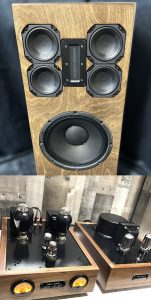
“The ultimate combo for SET aficionados”
 I have written five reviews on AricAudio’s preamplifiers and amplifiers in the last six years. Each was superlative in its build quality, physical appearance, and, most importantly, performance. They ranged in price from $3000 to $11,000, and each piece of gear exceeded by a wide margin in its price bracket and the performance level of competitors on the market. Recently, my dear friend and fellow Stereo Times reviewer Mike Wright published his take on AricAudio’s Super 6SN7 line stage and had nothing but accolades about its performance. He thought it went head to head with his twice as expensive VAC preamplifier. Based on my experience, AricAudio is one of the top-notch American artesian manufacturers, and Aric is a brilliant designer and craftsman of hand-built pieces. If you look on any of the audio forums, customers not only rave about their AricAudio equipment but find the type of customer support for their products to be first-rate.This review covers the AricAudio Super 2A3 SET amplifier, which retails for $5685, and the AricAudio Spectre 12 Loudspeaker, which retails for $8695 a pair. First, let me provide all the physical and design details for both the amplifier and loudspeakers before getting to the performance details, explaining why my time with both of them has been filled with pleasure and enjoyment of the music.
I have written five reviews on AricAudio’s preamplifiers and amplifiers in the last six years. Each was superlative in its build quality, physical appearance, and, most importantly, performance. They ranged in price from $3000 to $11,000, and each piece of gear exceeded by a wide margin in its price bracket and the performance level of competitors on the market. Recently, my dear friend and fellow Stereo Times reviewer Mike Wright published his take on AricAudio’s Super 6SN7 line stage and had nothing but accolades about its performance. He thought it went head to head with his twice as expensive VAC preamplifier. Based on my experience, AricAudio is one of the top-notch American artesian manufacturers, and Aric is a brilliant designer and craftsman of hand-built pieces. If you look on any of the audio forums, customers not only rave about their AricAudio equipment but find the type of customer support for their products to be first-rate.This review covers the AricAudio Super 2A3 SET amplifier, which retails for $5685, and the AricAudio Spectre 12 Loudspeaker, which retails for $8695 a pair. First, let me provide all the physical and design details for both the amplifier and loudspeakers before getting to the performance details, explaining why my time with both of them has been filled with pleasure and enjoyment of the music.

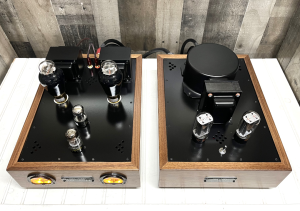
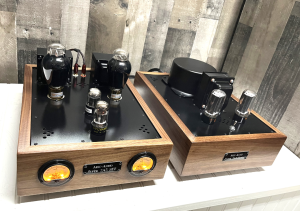

The first is the Super 2A3 SET amplifier. This amplifier is a two-chassis design. My demo was clad in beautiful zebra wood. The power supply weighs 38 pounds, and the amplifier chassis weighs 25 pounds. In front are two meters that monitor the current/biasing of the 2A3 power tubes. The port for the unique power connector is located on the back of both pieces, along with speaker wiretaps of 4 Ohms and 8 Ohms, depending on the speaker load. The Super 2A3 SET amplifier has NOS 6Sl7/6SN7/5U4GB and a pair of Linlai 2A3 power tubes. I asked Aric to explain his design, which differs from many SET amplifiers, and to bring to this review the many details that make this a special amplifier in both design and internal parts selection.
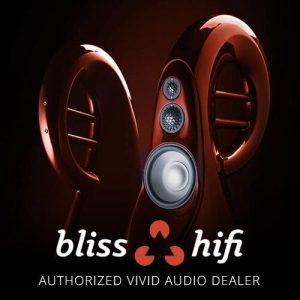 “My Super 2A3 was designed to get the most out of this “flea-watt” triode, which, as SET aficionados know, can only produce around 3-3.5 watts. I also didn’t want the driver stage or power supply running out of headroom interfering with the 2A3 being able to produce its rated power. Since we are limited to just a few watts, everything matters- the driver’s ability to provide clean voltage with a low impedance output, as well as the power supply’s ability to provide clean voltage and current for the driver and power tube to “swing” effortlessly to allow the power tube to do its job is crucial. Many amps would stick a 5U4G and a pair of 6SN7s in the design and call it a day, which works okay. Still, at the upper limits, the driver is slewing as it runs out of steam (the 6SN7’s plate drive is fairly weak- its cathode is another story), and the 5U4G will start to sag and drop more voltage, making the amplifier sound- well, saggy.
“My Super 2A3 was designed to get the most out of this “flea-watt” triode, which, as SET aficionados know, can only produce around 3-3.5 watts. I also didn’t want the driver stage or power supply running out of headroom interfering with the 2A3 being able to produce its rated power. Since we are limited to just a few watts, everything matters- the driver’s ability to provide clean voltage with a low impedance output, as well as the power supply’s ability to provide clean voltage and current for the driver and power tube to “swing” effortlessly to allow the power tube to do its job is crucial. Many amps would stick a 5U4G and a pair of 6SN7s in the design and call it a day, which works okay. Still, at the upper limits, the driver is slewing as it runs out of steam (the 6SN7’s plate drive is fairly weak- its cathode is another story), and the 5U4G will start to sag and drop more voltage, making the amplifier sound- well, saggy.
Instead, I’ve used a single 6SL7 input stage that can swing lots of voltage and direct-coupled it to a 6SN7 “follower” stage (so there is no coupling capacitor between the input and driver stages). The 6SL7 can drive the load of the 6SN7 grid easily, and it does not need cathode bypass caps- which can color the sound. Then, the 6SN7 drives the 2A3s grids from its strongest element- the cathode. In this “follower” arrangement, the 6SN7 imparts no sonic character to the signal being sent, as it operates on its internal feedback, making it very linear. In this arrangement, the 6SN7 buffers the 6SL7 from the world and can deliver some serious current and swing to the 2A3s, allowing them to reach full power long before the driver stage runs out of steam (in fact, the 6SN7 in this arrangement could drive a half dozen power tubes and keep on smiling!).
In the spirit of over-building, I chose an oversized toroidal power transformer housed in its own chassis, which can deliver up to 6 times the current that the amplifier needs. Rectification is handled via twin 5U4GBs so that the current is more than double what the amplifier requires. A massive 10H choke then filters out ripple after the first film filter capacitor, and after that, a bank of Vishay film caps does the rest of the filtering. Each filament has its toroidal filament transformer that is rectified to DC using Schottky diodes and large reservoir caps. This allows for a very clean, neutral, and high-quality power supply to allow the amplifier to do its thing without worrying about being under-fed from any angle.
The amplifier’s Internal components are equally proficient in rendering music transparently and with good timbre. I use pure copper wiring for all points in the signal, Transcendar output transformers, Duelund copper foil, paper in oil coupling caps, Vishay metal film precision resistors in the signal path, as well as film cathode bypass caps and heat sink mount Vishay cathode bias resistors for the 2A3s.A full hardwood wraparound chassis with thick aluminum top plates, copper shielding, and alloy isolation footers round out the amplifier.”
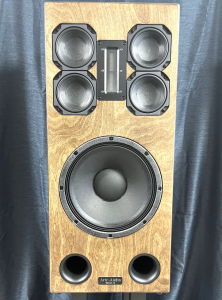



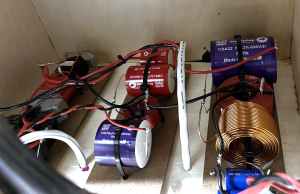
.jpg?KeepThis=true&TB_iframe=true&height=430&width=700) The AricAudio Spectre 12 loudspeakers are a six-driver design. Their dimensions are 35 inches x width of 14 inches x depth of 13 inches. Each speaker weighs 70 pounds. The physical appearance of the Spectre 12 loudspeaker reminded me very much of the reference Harbeth 40.3 XD, except that it is less in-depth than the English speaker. The Spectre 12 loudspeaker is rated from 32 Hz to 35,000 kHz. The nominal impedance is 8 ohms. The efficiency is 95.5 dB. When Aric asked if I would be interested in reviewing the Spectre 12 loudspeakers, I was initially surprised because I did not know he even built speakers! It turned out that he had been working on this design for over seven years. Part of why he finally decided to manufacture the Spectre 12 was that when customers would come to his shop to pick up what they had purchased, they would see and hear the loudspeaker and immediately want to purchase a pair! Aric describes this innovative design that “sings” with a 2-watt SET amplifier or a solid-state 500-watt design. Part of my auditioning process was to use the Spectre 12 with both types of amplifiers, and either type of amplifier superlatively drove it. I also discovered that stands 10 inches in height, in my listening space, were optimum for this pair of loudspeakers to maximize their performance.
The AricAudio Spectre 12 loudspeakers are a six-driver design. Their dimensions are 35 inches x width of 14 inches x depth of 13 inches. Each speaker weighs 70 pounds. The physical appearance of the Spectre 12 loudspeaker reminded me very much of the reference Harbeth 40.3 XD, except that it is less in-depth than the English speaker. The Spectre 12 loudspeaker is rated from 32 Hz to 35,000 kHz. The nominal impedance is 8 ohms. The efficiency is 95.5 dB. When Aric asked if I would be interested in reviewing the Spectre 12 loudspeakers, I was initially surprised because I did not know he even built speakers! It turned out that he had been working on this design for over seven years. Part of why he finally decided to manufacture the Spectre 12 was that when customers would come to his shop to pick up what they had purchased, they would see and hear the loudspeaker and immediately want to purchase a pair! Aric describes this innovative design that “sings” with a 2-watt SET amplifier or a solid-state 500-watt design. Part of my auditioning process was to use the Spectre 12 with both types of amplifiers, and either type of amplifier superlatively drove it. I also discovered that stands 10 inches in height, in my listening space, were optimum for this pair of loudspeakers to maximize their performance.
“I’ve always been a big fan of truly full-range multi-way loudspeakers with properly-designed crossovers, as I love the extended frequency spectrum they display. Unfortunately, most multi-way loudspeakers are inefficient and require high-powered amps to make them come to life. Many people go to single-driver loudspeakers, horns, or coaxials because low-powered SET amps can drive many. The problem with this solution is that many of these are unrefined or don’t have a full-frequency response. Then there are the ringing and cone breakup modes, which blare when any decent amount of power is pushed into the loudspeakers, creating the dreaded midrange “honk,” harsh highs, or doubling distortion in the bass frequencies. I also find most horn-loaded loudspeakers to cause fatigue after a short time, and my ears start to tingle, making me want to leave the room.
 There were not enough full-range, multi-way loudspeakers to be used with low-powered SET and high-powered SS amps, so this was my goal. To accomplish this, I chose drivers with a very flat response in their passband and high sensitivity that would gel well together with a minimum of crossover parts. Essentially no drivers are completely flat when run full-range, and all have their shortcomings, so I wanted to have a loudspeaker that maximized each driver where it naturally shines in its frequency response without the need for complex notch filters or higher order crossovers which suck the sensitivity (and thus dynamics) from them. I chose a ribbon tweeter that has excellent sensitivity and a flat curve that has the openness and air of a great metal dome tweeter but also the sweetness and non-fatiguing sound of a great soft dome and transitioned that to a natural-sounding midrange driver, which also has the same requirements. To keep the sensitivity on par with the tweeter, a quad of series/parallel wired 5″ pro sound, treated paper cone drivers that are made in Italy were chosen due to their natural presentation and the fact that this grouping and wiring arrangement lends them to have a very natural blend to the ribbon tweeter. They each have built-in shorting rings in the voice coil to lower IM distortion and are housed in their separate enclosure within the speaker cabinet to isolate them from the back wave of the 12″ woofer. A neodymium magnet case frame bass driver with an Xmax that exceeds many dedicated subwoofers was chosen for the bass. The driver itself is very lightweight due to its magnet structure and also has a very flat bass response. However, its best trait is that it can produce bass as low as 30 Hz in a very small vented alignment for this size driver. Thus, the bass is well-controlled and extends very deep, making a subwoofer completely unnecessary unless you own a dance club!
There were not enough full-range, multi-way loudspeakers to be used with low-powered SET and high-powered SS amps, so this was my goal. To accomplish this, I chose drivers with a very flat response in their passband and high sensitivity that would gel well together with a minimum of crossover parts. Essentially no drivers are completely flat when run full-range, and all have their shortcomings, so I wanted to have a loudspeaker that maximized each driver where it naturally shines in its frequency response without the need for complex notch filters or higher order crossovers which suck the sensitivity (and thus dynamics) from them. I chose a ribbon tweeter that has excellent sensitivity and a flat curve that has the openness and air of a great metal dome tweeter but also the sweetness and non-fatiguing sound of a great soft dome and transitioned that to a natural-sounding midrange driver, which also has the same requirements. To keep the sensitivity on par with the tweeter, a quad of series/parallel wired 5″ pro sound, treated paper cone drivers that are made in Italy were chosen due to their natural presentation and the fact that this grouping and wiring arrangement lends them to have a very natural blend to the ribbon tweeter. They each have built-in shorting rings in the voice coil to lower IM distortion and are housed in their separate enclosure within the speaker cabinet to isolate them from the back wave of the 12″ woofer. A neodymium magnet case frame bass driver with an Xmax that exceeds many dedicated subwoofers was chosen for the bass. The driver itself is very lightweight due to its magnet structure and also has a very flat bass response. However, its best trait is that it can produce bass as low as 30 Hz in a very small vented alignment for this size driver. Thus, the bass is well-controlled and extends very deep, making a subwoofer completely unnecessary unless you own a dance club!
 Due to the individual drivers’ linear and well-damped natural frequency response, they sound extremely natural and balanced, which allows fairly basic 2nd order filters to be used that sum all drivers in phase. I build the crossovers using only top shelf, transparent components, and low DCR coils to allow the signal to pass unadulterated to the drivers and allow them to shine with SET amplifiers as low as 1.5 watts (yes, I’ve used both a 45 triode and an EL84 wired in triode-mode to drive these loudspeakers to levels you’d have to shout to talk over), and yet still maintain clarity and composure when being driven by a 250 watt per channel pro sound AB amplifier that has its clip lights flashing. In my opinion, the see-saw of high sensitivity and controlled high power handling is perfectly balanced with these loudspeakers. It only made sense to have the cabinets made in California out of 11-ply Baltic Birch with substantial cross-bracing and a natural 4-layer epoxy-style finish to protect them. Matching stands that place the loudspeakers at the optimal height are also included. The prototypes of these speakers were built over seven years ago, and I used them exclusively to build and test all of my vacuum tube equipment during that time. I feel they allow every nuance of the signal to shine through, giving the user both a microscope and a macroscope to fully express their music!”
Due to the individual drivers’ linear and well-damped natural frequency response, they sound extremely natural and balanced, which allows fairly basic 2nd order filters to be used that sum all drivers in phase. I build the crossovers using only top shelf, transparent components, and low DCR coils to allow the signal to pass unadulterated to the drivers and allow them to shine with SET amplifiers as low as 1.5 watts (yes, I’ve used both a 45 triode and an EL84 wired in triode-mode to drive these loudspeakers to levels you’d have to shout to talk over), and yet still maintain clarity and composure when being driven by a 250 watt per channel pro sound AB amplifier that has its clip lights flashing. In my opinion, the see-saw of high sensitivity and controlled high power handling is perfectly balanced with these loudspeakers. It only made sense to have the cabinets made in California out of 11-ply Baltic Birch with substantial cross-bracing and a natural 4-layer epoxy-style finish to protect them. Matching stands that place the loudspeakers at the optimal height are also included. The prototypes of these speakers were built over seven years ago, and I used them exclusively to build and test all of my vacuum tube equipment during that time. I feel they allow every nuance of the signal to shine through, giving the user both a microscope and a macroscope to fully express their music!”
I did a lengthy review, trying out the Super 2A3 SET amplifier with at least five different speakers and the Spectre 12 speakers with four different amplifiers. In either case, both pieces produced excellent results across all the parameters I used to evaluate the performance of the review equipment. However, the synergy of the AricAudio Super 2A3 SET amplifier with his Spectre 12 speakers was such an immensely beautiful musical experience that I decided to review them as a “Combo” instead of individual components. I would also like to share that of all the tubes that can be used in a SET design, the 2A3, if set up correctly, is my all-time favorite power tube to be used this way.
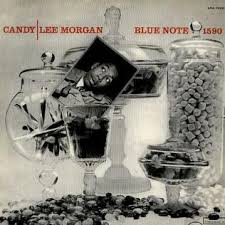 I’ll use two of my favorite jazz “chestnuts” and a brand new album by a legendary tenor saxophonist to get across how the combo of the Super 2A3 SET amplifier and the Spectre 12 speakers render an illusion of live music at a very high level. My all-time favorite trumpet player is Lee Morgan. I used his Blue Note album “Candy” to hear if the combo could accurately produce the rich, warm, and sweet timbres/tonality of his playing, along with the speed and pop when Morgan would soar effortlessly towards a crescendo at the end of his improvised run. The combo reproduced this better than I had ever heard, and I have been listening to this recording for over fifty years!
I’ll use two of my favorite jazz “chestnuts” and a brand new album by a legendary tenor saxophonist to get across how the combo of the Super 2A3 SET amplifier and the Spectre 12 speakers render an illusion of live music at a very high level. My all-time favorite trumpet player is Lee Morgan. I used his Blue Note album “Candy” to hear if the combo could accurately produce the rich, warm, and sweet timbres/tonality of his playing, along with the speed and pop when Morgan would soar effortlessly towards a crescendo at the end of his improvised run. The combo reproduced this better than I had ever heard, and I have been listening to this recording for over fifty years!
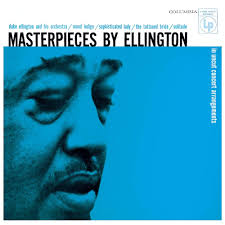 Next up was the Duke Ellington album “Masterpieces by Ellington,” which is considered one of the most important recordings in the history of jazz, both in terms of the quality of the recording and the music.
Next up was the Duke Ellington album “Masterpieces by Ellington,” which is considered one of the most important recordings in the history of jazz, both in terms of the quality of the recording and the music.
The level of tonal beauty, the remarkable transparency allowing all the nuances/micro-details to be easily heard, and the depth and width of the soundstage reminded me of listening to a world-class large electrostatic or planar-magnetic panel speaker. However, the individuals’ location and realistic size were like a great two-way monitor. The amount of power and dynamics were all there on loud passages, with Ellington’s band working towards a powerful conclusion, which is remarkable considering we are talking about 3.5 watts—no distortion or attenuation at very high dB levels.
Finally, the new album by the great tenor saxophonist Charles Lloyd, “The Sky Will Still Be There Tomorrow,” and his terrific working band of young Turks, remember Lloyd is 86 years old and still kicking it, immersed me in beautiful music. The Spectre 12 speakers completely disappeared, and the music wrapped around me, and I felt like I was in the studio with these great musicians.
When I tested the AricAudio Super 2A3 SET amplifier with other speakers, it provided a pure tonality, a shimmery detailed top end, and tight, accurate bass. This amplifier is not a “cuddly” SET 300B sounding amplifier. But if you cherish pristine timbres, a fast, silky, smooth presentation, a three-dimensional mid-band, an overall linear presentation top to bottom, and a surprising amount of pop and dynamics, you will love the Super 2A3 SET amplifier. The Spectre 12, when driven by other amplifiers, still rendered a level of transparency that rivals electrostatic designs, overall effortless liquidity, a powerful bass foundation, world-class soundstaging with accurate layering and placement of individuals on that stage, and finally, a subjective quality that allows you to relax into the emotional aspects of the music. When you combine both, you get a synergy of the Super 2A3 SET amplifier’s finest aspects and Spectre 12 speakers, a match made in sonic heaven. If you are an aficionado of SET “Flea Watt” amplifiers, you owe it to yourself to hear the Spectre 12 speakers. If you already own an AricAudio preamplifier or amplifier, consider hearing your great amplification with his new speaker design to take your listening satisfaction to a higher level.


Specifications:
Spectra 12 Loudspeakers
Price: $8,695.00
5″ Ribbon Tweeter with high sensitivity and extension to 35khz
Four 5″ Italian-made Pro Sound midrange drivers with aluminum demodulation rings and ruler flat response
12″ cast-frame, neodymium magnet bass driver with 8 mm linear one way Xmax and extension down to 32 hz
Cardas copper binding posts
Isolated enclosure for midrange drivers
Extensive internal bracing for a very resonant free cabinet
PTP wired crossovers featuring Clarity Cap CMR and SA series, Jantzen shunt capacitors and air core inductors, Erse Super Q bass inductor, Mills resistors and Audio Quest 14 gauge internal wiring
Super 2A3 Set
Price: $5,685.00
Single 6SL7 input stage
Input stage DC coupled to a 6SN7 cathode follower driver stage
Massive overbuilt toroidal power transformer
Twin 5U4GB tube rectifiers
Transcendar output transformers with 4 and 8-Ohm taps
Independent DC power supplies for the 2A3 filaments
All film capacitors used in the power supply
Vishay resistors used throughout
Film capacitors used for cathode bypass
Film capacitor cathode noise reduction
Duelund JDM coupling capacitors
Twist lock umbilical power cables
Completely PTP wired and handcrafted in the USA
Associated Equipment
Sources:
Pass Labs DAC-1
Reimyo DAP-999 Limited “Toku”
Pro-Jet reference CD transport & Linear Tube Audio Supply
CEC- 3 belt CD transport
Mark Levinson 31.5 transport
Amplification:
Coda 07X preamplifier
Coda S5.5 amplifier
SPL Elector Preamplifier
SPL S1200 amplifier
AricAudio Super SET 300B amplifier
AricAudio Motherlode MKII preamplifier
Loudspeakers:
NSMT System Two speakers
Musician Audio – Knight one speakers & NSMT band pass one subwoofers
Accessories:
Black Cat Cables -digit 110 AES/EBU-3202 XLR ICs
Krimuss Audio Adrenaline speaker cables
Krolo Design reference rack & footers
Puritan Design power conditioner & circuit grounding system
Audio Archon power cords
Stereo Times Masthead
Publisher/Founder
Clement Perry
Editor
Dave Thomas
Senior Editors
Frank Alles, Mike Girardi, Russell Lichter, Terry London, Moreno Mitchell, Paul Szabady, Bill Wells, Mike Wright, and Stephen Yan,
Current Contributors
David Abramson, Tim Barrall, Dave Allison, Ron Cook, Lewis Dardick, John Hoffman, Dan Secula, Don Shaulis, Greg Simmons, Eric Teh, Greg Voth, Richard Willie, Ed Van Winkle, Rob Dockery, Richard Doran, and Daveed Turek
Site Management Clement Perry
Ad Designer: Martin Perry





Be the first to comment on: AricAudio Super 2A3 SET Amplifier & Spectre 12 Loudspeakers by Terry London